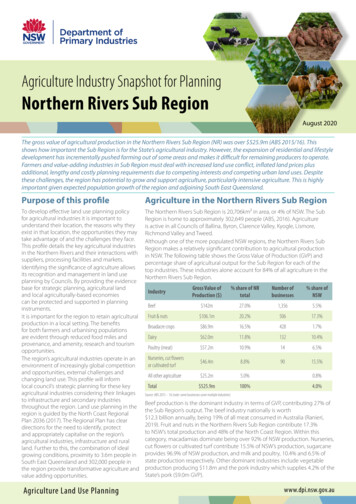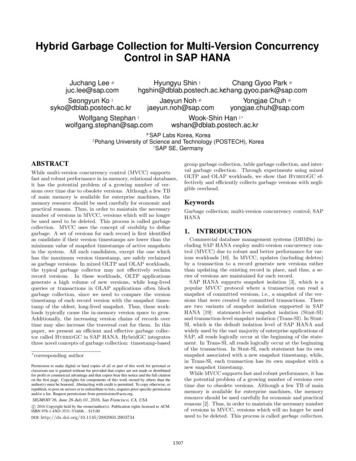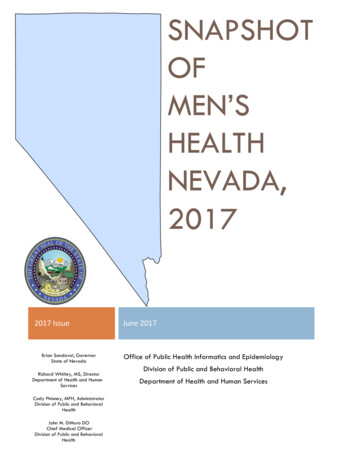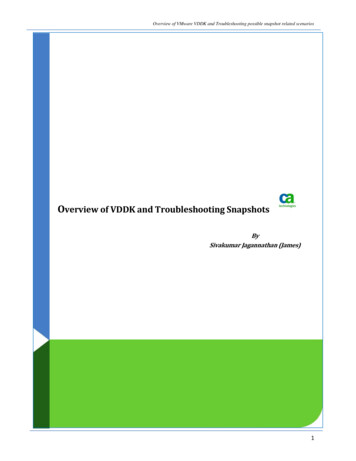
Transcription
Agriculture Industry Snapshot for PlanningNorthern Rivers Sub RegionAugust 2020The gross value of agricultural production in the Northern Rivers Sub Region (NR) was over 525.9m (ABS 2015/16). Thisshows how important the Sub Region is for the State’s agricultural industry. However, the expansion of residential and lifestyledevelopment has incrementally pushed farming out of some areas and makes it difficult for remaining producers to operate.Farmers and value-adding industries in Sub Region must deal with increased land use conflict, inflated land prices plusadditional, lengthy and costly planning requirements due to competing interests and competing urban land uses. Despitethese challenges, the region has potential to grow and support agriculture, particularly intensive agriculture. This is highlyimportant given expected population growth of the region and adjoining South East Queensland.Purpose of this profileAgriculture in the Northern Rivers Sub RegionTo develop effective land use planning policyfor agricultural industries it is important tounderstand their location, the reasons why theyexist in that location, the opportunities they maytake advantage of and the challenges they face.This profile details the key agricultural industriesin the Northern Rivers and their interactions withsuppliers, processing facilities and markets.Identifying the significance of agriculture allowsits recognition and management in land useplanning by Councils. By providing the evidencebase for strategic planning, agricultural landand local agriculturally-based economiescan be protected and supported in planninginstruments.It is important for the region to retain agriculturalproduction in a local setting. The benefitsfor both farmers and urbanising populationsare evident through reduced food miles andprovenance, and amenity, research and tourismopportunities.The region’s agricultural industries operate in anenvironment of increasingly global competitionand opportunities, external challenges andchanging land use. This profile will informlocal council’s strategic planning for these keyagricultural industries considering their linkagesto infrastructure and secondary industriesthroughout the region. Land use planning in theregion is guided by the North Coast RegionalPlan 2036 (2017). The Regional Plan has cleardirections for the need to identify, protectand appropriately capitalise on the region’sagricultural industries, infrastructure and ruralland. Further to this, the combination of idealgrowing conditions, proximity to 3.6m people inSouth East Queensland and 302,000 people inthe region provide transformative agriculture andvalue adding opportunities.The Northern Rivers Sub Region is 20,706km² in area, or 4% of NSW. The SubRegion is home to approximately 302,649 people (ABS, 2016). Agricultureis active in all Councils of Ballina, Byron, Clarence Valley, Kyogle, Lismore,Richmond Valley and Tweed.Although one of the more populated NSW regions, the Northern Rivers SubRegion makes a relatively significant contribution to agricultural productionin NSW. The following table shows the Gross Value of Production (GVP) andpercentage share of agricultural output for the Sub Region for each of thetop industries. These industries alone account for 84% of all agriculture in theNorthern Rivers Sub Region.Agriculture Land Use PlanningGross Value ofProduction ( )% share of NRtotalNumber ofbusinesses% share ofNSWBeef 142m27.0%1,3565.5%Fruit & nuts 106.1m20.2%50617.3%Broadacre crops 86.9m16.5%4281.7%Dairy 62.0m11.8%13210.4%Poultry (meat) 57.2m10.9%146.5%Nurseries, cut flowersor cultivated turf 46.4m8.8%9015.5%All other agriculture 25.2m5.0%0.8%Total 525.9m100%4.0%IndustrySource: ABS 2015 – 16 (note: some businesses cover multiple industries)Beef production is the dominant industry in terms of GVP, contributing 27% ofthe Sub Region’s output. The beef industry nationally is worth 12.3 billion annually, being 19% of all meat consumed in Australia (Ranieri,2019). Fruit and nuts in the Northern Rivers Sub Region contribute 17.3%to NSW’s total production and 48% of the North Coast Region. Within thiscategory, macadamias dominate being over 92% of NSW production. Nurseries,cut flowers or cultivated turf contribute 15.5% of NSW’s production, sugarcaneprovides 96.9% of NSW production, and milk and poultry, 10.4% and 6.5% ofstate production respectively. Other dominant industries include vegetableproduction producing 11.8m and the pork industry which supplies 4.2% of theState’s pork ( 9.0m GVP).Northernwww.dpi.nsw.gov.auRivers Sub Region1
EmploymentAgriculture employs over 4,806 people across the Northern RiversSub Region (ABS, 2015/16). The biggest employer is cattle and grainfarming (34.4%) followed by the fruit and nut industries (23.0%)and nursery and floriculture production (8.0%). The LGAs with thehighest agriculture employment are Lismore (19.6%) and ClarenceValley (16.9%) These are people employed in the primary productionof agriculture and do not include the vast workforce within the keysecondary industries. It does not include employees that are hiredon a seasonal basis that were not working in the Northern Rivers SubRegion at the time of the ABS census.Local government distributionThe following map shows the local government areas (LGA’s) in theregion and agricultural GVP. The biggest individual contribution isClarence Valley Council followed by Kyogle Council.MilkBeefFruit/nutsBroadacre cropsHighest to lowest GVP 13.47m 7.73m 7.14mTweedKyogleGVP 40.8m 7.8% NRByron 36.56m 18.4m 17.47mGVP 86.1m 16.4% NR 12.8m 9.31m 4.02mLismoreGVP 32.1m 6.1% NRBallinaRichmond Valley 28.96m 23.32m 13.25m 40.16m 22.97m 7.17mGVP 81m 15.4% NRGVP 74.3m 14.1% NRClarence Valley 36.53m 16.13m 15.86mGVP 91.8m 17.5% NR 52.04m 42.82m 11.91mGVP 119.8m 22.8% NR2Poultry meat% NR per cent share of Northern Rivers Sub Region Agriculture GVPVegetablesNorth Coast Planning RegionNurseries, cut flowers or cultivated turfAgriculture Industry Snapshot for Planning
Agricultural highlights of the Northern Rivers Sub RegionFarming in the Northern Rivers Sub Region provides benefits and opportunities for producers and urban populations. By sustainingagriculture close to large cities (the peri-urban area), there are advantages for farmers ranging from opportunities with marketdifferentiation and alternative income streams, access to labour, resources and materials, and opportunities to grow high valuecrops which benefit from market proximity (reduced food miles and spoilage).This section highlights the prominent industries for the Northern Rivers Sub Region, with further detail provided in Appendix 1.BeefThe beef industry is a major contributor to agriculturalproduction in the Northern Rivers region. The gross value ofproduction of beef in the Northern Rivers was 142m in2015/16 accounting for 5.5% of NSW production (ABS 2015/16).The beef industry consistently remains a major employer inthe region, along the whole supply chain, including growing,transport, refrigeration, processing and production (RDA 2015).The Northern Cooperative Meat Company (NCMC), Australia’slargest meat processing Co-operative, is located in the regionsupporting the beef, pork and other meat industries. NCMC is100% member owned. The NCMC facilities include a red meatprocessing facility and tannery located at Casino, and a porkprocessing facility at Booyong (Byron LGA). These facilities areperfectly positioned to draw livestock from some of the bestfarming regions in Australia and are within close proximity tothe Port of Brisbane, a major export hub (NCMC 2020). The Casino Service Processing facility processes up to 9,000animals per week across two processing floors (beef andveal) and exports to more than 20 countries (NCMC 2020). Casino Hide Tannery (CHT) is part of the NCMC group,processing hides from green through to wet blue leather.Established in 1975, CHT was one of the first tanneriesin Australia dedicated to the tanning of cattle hides forexport. The tannery is one of the larger installations inAustralia, with the capacity to convert over 900,000 cattlehides each year (CHT 2020).The Northern Rivers Sub Region proximity to markets includinglocal saleyards at Casino, Grafton, Lismore and Murwillumbahare critical to the continued viability of the industry within theregion. The Northern Rivers Livestock Exchange on the outskirtsof Casino is the largest livestock trading facility in northern NSWserving a producer catchment well beyond the Sub Regionincluding, parts of the Mid-North Coast, the western slopesof the Northern Inland and some producers from South EastQueensland (RDA 2015).Industry requirementsThe Northern Rivers has ideal conditions for pasture fed cattleproduction given the climate, high rainfall and access to both alocal international processing facility (NCMC at Casino) and theJBS processing facility at Dinmore, in South East Queensland.Producers require scale of land holdings and room to expandoperations. Access to processors, saleyards, transport and asuitable workforce are also important.The key inputs for the beef industry are: feed, mainly rain fed pasture and/or seasonalsupplementary grain/hay suitable fencing and infrastructure road access for feed and livestock transport reliable water supply access to labour access to processing facilities and saleyards ability to expand or intensify operations to increase scalewithout interruption from non-farming residents.The NSW North Coast is highly susceptible to flooding. It isimportant that grazing properties have a good balance ofsloped country in association to alluvial flats to ensure adequateflood refuge is provided. While the fertile soils of the alluvial flatscan produce quality pasture, flatter land can also be susceptibleto frosts so access to hilly country can also ensure continuedaccess to more palatable pastures during winter months.Northern Rivers Sub Region3
Fruit and nutsBroadacre crops - sugarcaneThe Northern Rivers Sub Region is home to many key fruit andnut industries for NSW. The most significant to the State’sproduction is macadamias followed by bananas and avocados.CategoryFruit & nuts(excludinggrapes)Key industryGVP% share of NSWMacadamias 80.6m92.9%Avocadoes 8.7m24.3%Blueberries 6.3m5.4%Bananas 2.7m42.8%Mangoes 123,89036.9%Macadamia nuts are the fourth largest Australian horticulturalexport. The macadamia plant originated in the coastal areasof northern NSW and south east Queensland. In 2016 theNorthern Rivers Sub Region produced 40% of Australianproduction. The region has plantations with more thanthree million trees over 9,700ha of land, with 490 producers(AMS 2020). The expansion of the industry is limited due tourban encroachment in the coastal hinterland, resulting inthe industry spreading into other areas including the coastalfloodplain.The Northern Rivers Sub Region has six macadamia processingplants, which process nuts from growing regions aroundAustralia. These include MWT Foods and Swiss Gourmet inAlstonville Estate & Waliz Nuts, at Newrybar; Macadamias Directat Dunoon; Marquis Macadamias at Alphadale, near Lismore;and Pacific Farm Services at Brooklet, near Bangalow.Industry requirementsThe industry relies on machinery and irrigation equipmentsuppliers, mechanics, freight and logistics industries, competenttrades and rural supply stores.The key inputs for the macadamia industry are: well drained, fertile, deep soils on slopes less than 15% a temperate frost-free climate without excessivetemperatures and winds access to transport and processing industries access to workforce reliable water supply ability to expand operations including buffers with noncompatible land uses.4Agriculture Industry Snapshot for PlanningSugarcane is worth over 2 billion to the Australian economyand is the second largest export crop following wheat. Morethan 96% of NSW’s sugar production occurs in the NorthernRivers Sub Region on over 34,000ha predominantly located inthe Tweed, Richmond and Clarence Valley LGAs (NSW Sugar2020). Processing mills are located at Condong (Tweed LGA)and Broadwater and Harwood in Clarence Valley LGA. A sugarrefinery is also located at Harwood. The industry is underincreasing pressure from urban development and changingagricultural land uses.Industry requirementsSugarcane growing requires unconstrained, relatively flat, welldrained land. Other requirements are: appropriate and maintained drainage infrastructure access to processing facilities transport links access to workforce ability to maintain critical mass and expand operations value adding opportunities for by products.Dairy industryThe dairy industry in the region was established in 1870 and ischaracterised by family owned and operated farms producingmilk for national and export markets. The industry produced 62m in GVP in 2015/16 which is 10.4% of NSW’s dairy GVP forthat year. The biophysical characteristics of the Northern RiversRegion are ideal for pasture-based dairying. The farmer-ownedNorco dairy co-operative head office is based in Lismore alongwith Norco’s ice-cream processing facility.Value-add industries derived from dairy products such as artisancheesemaking are also emerging, examples including NimbinValley Dairy (Lismore LGA); Tweed Valley Farmhouse Cheesesand Cheeses Love You (Tweed LGA).The Northern Rivers Sub Region dairy industry however hasexperienced a fall in farm numbers following changes in farmgate prices. This has encouraged a shift to larger more intensiveoperations with greater economies of scale.Industry requirementsFarmland in the region is also in demand for rural lifestyledevelopment which is incompatible with dairying. The industrytherefore needs policy support through land use planning tomanage potential land use conflict from incompatible landuses.Other key requirements include: access to supplementary feed, water and electricity supply access to workforce access to processors and export markets suitable road and bridge infrastructure and access totransport ability to increase scale and intensity of operations.
PoultryDemand for poultry meat continues to grow across NSW (DPI,2019) and there is pressure on farms to increase supply. Poultryfarming in the Northern Rivers Sub Region was worth morethan 57m in 2015/16 with the majority of farms located in theRichmond Valley, Lismore and Kyogle LGAs. While historicallyimportant to the Sub Region, the processing capacity for thepoultry industry has recently changed. Processing was largelyserviced by South East Queensland and a local processingfacility located at West Byron. The West Byron facility closed in2014 and supply contracts with Queensland based processorshave expired and will not be renewed. This is largely as a resultof structural changes to the Queensland industry and efficiencylosses associated with the distances needed to travel toprocessing plants from the Sub Region’s farms.With the removal of broiler production opportunities in theregion, remaining growers are considering opportunities forre-purposing their existing infrastructure and new venturesmay emerge. Poultry value-add industries continue to operatein the region. Specialised Chicken, based in Murwillumbah,in the Tweed LGA are wholesale chicken specialists supplyingbusinesses throughout Australia. Specialised Chickenmanufacture fresh raw and value-added chicken and othermeat products (Specialised Chicken 2020).Nurseries/cut flowers/turfThe nursery industry is an important industry for the NorthernRivers Sub Region, worth 46.4m in GVP in 2015/16 whencombined with cut flowers and turf. The category represents15.5% of NSW GVP and nurseries alone represent more than aquarter of the State’s production with 37.3m GVP. The industryis critical to the region’s commercial horticultural industry aswell as providing products for the domestic gardening andlandscape industry.Industry requirementsThe nursery industry relies on many of the similar secondaryindustries as the other agricultural industries in the region beingmachinery and irrigation equipment suppliers, mechanics,freight and logistics industries, competent trades and ruralsupply stores. The industry also requires specialist potting mixsuppliers and suppliers of pots and associated equipment,which are readily transportable and availableNorthern Rivers Sub Region5
Northern Rivers Regional assets for agricultureSupporting industries andinfrastructureBefore agricultural produce makes it to market, there are inputssuch as fertiliser, fuel, technical support services such asagronomists, vets and mechanics, processing facilities such asabattoirs, packing plants, cleaning facilities, transport access andinfrastructure, etc. The unfettered access to infrastructure andsupporting industries is critical to the ongoing production offood and fibre from agriculture. Some key secondary industriesinclude abattoirs, tanneries, milk processors, mills and saleyards.The Northern Rivers Region’s agricultural industries havea comprehensive and diverse supply of support servicesand infrastructure in proximity. The interactions of theseagricultural industries with their secondary industries is a criticalconsideration in planning for agricultural land uses.ClimateThe Bureau of Meteorology characterises the Northern RiversSub Region climate zone as sub-tropical with warm summers,cool winters and high rainfall, especially near the coast. Averagerainfall on the coast is over 1,600mm and 800-1,200mm on theGreat Dividing Range. This combined with biophysical assetssuch as water and soils, supports a diverse agricultural industrywith regional specialisations in horticultural, milk, nursery andsugarcane production. It will be increasingly important toprotect land and resources that support agriculture in theregion to enable sustained production of specialised agricultureenterprises against the future risks of climate change.SoilsThe unique and inherent biophysical assets of the NorthernRivers Sub Region are well recognised. The development of thesoil landscape in the Northern Rivers has been heavilyinfluenced by the Mt Warning shield volcano producing richvolcanic soils that are highly productive and suitable for a widevariety of agricultural commodities. The landscape is also highlyinfluenced by the major river systems that flow through theregion associated with the Tweed, Richmond and Clarencerivers. Expansive alluvial floodplains dominate the lower reachesof these systems. These soils combined with the climate andrainfall assets of the region provide the ideal attributes foragricultural production of broadacre crops such as sugar caneand soya beans.The need to protect the region’s biophysical assets for currentand future agricultural production has been a long-terminitiative of the NSW Government. The Northern Rivers FarmlandProtection Project 2005 identified those farmlands with thehighest quality biophysical attributes for food production. Thismapping was updated in 2020 to include an infill area west ofKyogle. Provisions are included within the planning system toprotect this land from urban and rural residential encroachment.6Agriculture Industry Snapshot for PlanningLocational advantageThe proximity of the region to South East Queensland and localmarkets and processing centres provided by the M1 PacificMotorway allows for specialisation in food manufacturing andproduction of highly perishable fresh products such as dairyand vegetables. Commuting infrastructure in the region enablesaccess to a skilled workforce to service food manufacturing andagribusiness. Rising interest in Australian agriculture is linked toawareness of food production systems, reducing ‘food miles’and buying locally, as well as demand for fresh (seasonality) andhigh nutritional quality of food consumed (‘clean and green’). Itis also recognised that agricultural land provides ecosystemservices, food security and other benefits for urbanisingcommunities that warrant its support and preservation throughplanning instruments, despite inherent difficulties withcoexistence with urban sprawl (Brinkley, C, 2012). The NorthernRivers Sub Region has reciprocal advantages for producersproviding these services with markets, export potential, accessto supply chain and value adding.InfrastructureThe Northern Rivers Sub Region lies at the crossroads of keytransport links connecting NSW and Queensland. Its major roadlinks are the Pacific Highway, Bruxner Highway and SummerlandWay. The region is effectively positioned close to the Brisbanemarkets and Port of Brisbane and future travel time cuts fromPacific Highway upgrades will reduce transport times to Sydneymarkets. Ballina acts as the Region’s main airport with dailyservices to Newcastle, Melbourne and Sydney. Lismore Airportprovides services to Sydney and Grafton. While beyond theRegion, the Gold Coast International Airport provides animportant alternative for connections to domestic and overseasmarkets (NR REDS). The Port of Yamba is a key asset in the regionand is currently used for agricultural exports, with potential toexpand the capacity to other forms of agricultural produce.Freight infrastructure includes warehousing and logistics in theNorthern Rivers region, servicing ports and air services in Ballina,Grafton and over the border in South East Queensland. Thisinfrastructure and connections give the region a competitiveadvantage.EntrepreneurialismA report by the NBN in 2017 referenced an ‘entrepreneurialenergy and enterprise’ across the Northern Rivers SubRegion. The report identified the region as one of the mostprogressive parts of Australia attracting progressive thinkersand entrepreneurs. There are many examples of innovation andentrepreneurialism within the agricultural, food and beveragesector throughout the region including in technologicaladvances, food processing, distilleries etc. This is highlyimportant for the region particularly given the high level ofhistorical fragmentation of agricultural land and the needfor farmers to diversify incomes to remain viable on smallerholdings.
Challenges for agriculture in the Northern Rivers Sub Region and planningsolutionsAgricultural land is a finite resource, particularly in the Norther Rivers Sub Region where decades of fragmentation has adverselyaffected agriculture. This section highlights some of the challenges faced and planning solutions.Historic land use planningHistorical planning policy has not strategically valued andprotected rural land in peri-urban areas, instead regarding it as‘urban land in waiting’ (Houston, 1993).The absence ofdedicated planning policy for agriculture has resulted in LocalEnvironmental Plans (LEPs) across the state, that do not supportagriculture in practice. Agriculture has spatial, biophysical andproduction criteria that can be similar to industrialdevelopment, especially intensive industries. However, in LEPsindustrial zones are located in dedicated areas withdevelopment controls managing incompatible development. Incontrast, rural planning provisions often allow incompatibledevelopment and subdivision that affect farm amalgamations,expansion or intensification plans and ultimately restrict afarmer’s ability to make a living.This trend if it continues can mean that: over time less land will be available for agriculturalproduction within close proximity to regional towns andcities such as Lismore, Grafton and Ballina the external impacts on the remaining agricultural activitieswill need more specialised management at the urbanfringe some agricultural activity may be displaced and mayleave the region altogether, as evidenced by the dairy andpoultry industry moving from metropolitan regions toother regions.Planning solutionFuture land use planning must recognise the importanceof agriculture to society and the economy and also that theland and resources on which agriculture depend need to beprotected and managed to enable continued use of the landfor agriculture. The above challenges can lead to the followingadverse impacts for agriculture if they continue to occur: Inflated land prices prevent farm expansion as residentialland values are in a different market to agricultural landvalues. Differing expectations: Complaints are made toauthorities from neighbouring residents about legalfarming activities such as traffic movements, dust, noise,odour etc., resulting in adjustments being required tooperations. Loss of critical mass: Urban encroachment graduallyresults in the loss of farmland and supporting services (acritical mass required for commercial viability), requiringfarmers to source further afield. Uncertainty: Land use conflict and the variable impacts onfarming makes it difficult to plan for future investment inthe industry. Pressures of encroaching development oftenresult in farmers either selling land for non-rural uses orcontinuing to farm with the issue of land use conflict.Northern Rivers Sub Region7
Statutory land use decisionmakingThe time and cost involved in the development approvalprocess can constrain the capacity of agriculture industries toquickly respond to market forces. Intensive agriculture land usesoften require extensive site and impact assessments fromspecialist consultants and state agencies, while perceivedenvironmental impacts on neighbouring properties can raiseconcerns in a community about the potential impact ofintensive agricultural land use.Planning solutionClear development controls which specify requirements forintensive agricultural development, and non-agriculturaldevelopments near existing agricultural land uses, are integralto minimizing community concerns and avoiding unnecessarycost and delays. Consistent requirements for informationto support development applications can also streamlinethe application process for proponents and assist consentauthorities to manage community expectations. It is importantfor both the agricultural industry and the community thatthe development approval process results in well managedagricultural land uses in the right location to enable thecontinued use of the land for agricultural production for thebenefit of the wider community.With a change in the social landscape of rural areas, conflictemerges from the presence of two different ‘types’ of ruralresidents, farmers and lifestylers, who cohabit within the ruralzones for different reasons - production versus amenity (Asklandet al 2019). Expansion of urban land uses and rural residentialhousing in rural areas creates potential for land use conflict withagricultural land uses. This in turn places pressure on producersto adjust their normal farming practices to minimise impactswhich can increase costs and threaten viability.Agricultural producers also need protection from the pressuresthat urbanisation brings to provide them with certainty andconfidence to invest in new technologies to intensify theirfarming operations and ensure that their enterprises remainviable. There remains a shared responsibility across all levelsof government, industry and the community to value theimportance of agriculture in food and fibre production,to protect high quality agricultural lands from furtherfragmentation and encroachment of non-compatible land uses,and to ensure agricultural activities are lawful and adhere tobest management practice.High quality agricultural land in the Northern Rivers Sub Regionis a finite resource and agricultural resources experience highspatial constraints. Agricultural production is alreadycharacterised by intensive and high value enterprises. Theongoing conversion of agricultural land to other nonagricultural land uses is creating major constraints to local foodproduction. When additional land is not available for expansionof farming operations the only way to increase productivity isintensification of operations, a process which can increase thepotential impacts of agriculture on surrounding non-agriculturalland uses. Additionally, indirect limitations on the ability foragricultural land uses to expand to remain viable, reduces theirability to adapt to changing externalities such as climate changeand both domestic and international market forces.The land use zones that apply to the land on which agricultureoccurs permit a wide range of other land uses. As populationgrowth requires increased residential development there willbe pressure to use rural land on the periphery of urban areasto accommodate residential development and other urbanland uses. This competition for rural land on which agriculturecan occur can lead to increased land prices and uncertainty foragricultural industries and investors. This competition for landoften results in dislocation and transfer of agriculture to otherareas, sometimes at great personal cost to producers and theirindustry.Planning solutionPlanning solutionLand use conflictPlanning policy and controls which prevent land uses in ruralareas that are incompatible with agriculture can minimise thepotential for land use conflict. Planning controls which requireadequate buffer distances between land uses can mitigatepotential impacts from agricultural land uses.8Urban encroachment andcompeting land usesAgriculture Industry Snapshot for PlanningPlanning controls which limit the range of non-agriculturalland uses that are permissible in zones applied to agriculturalland can prevent the encroachment of urban land uses onagriculture. Clear and robust strategic planning policy and landuse strategies are important to guide future urban growth tolocations where it will not have adverse impacts on agriculture.
Land fragmentationRural zoned land for agriculture (Primary Production -RU1, Rurallandscape - RU2 and Rural Small Holdings -RU4 zones) make uponly approximately 58% of the Northern Rivers Sub Region.Rural land in the region is characterised by a highly fragmentedland use pattern. Analysis of rural land in the Region found that: 30% is comprised of less than 5 hecta
Agriculture Industry Snapshot for Planning. Northern Rivers Sub Region. The gross value of agricultural production in the Northern Rivers Sub Region (NR) was over 525.9m (ABS 2015/16). This . shows how important the Sub Region is for the State's agricultural industry. However, the expansion of residential and lifestyle










